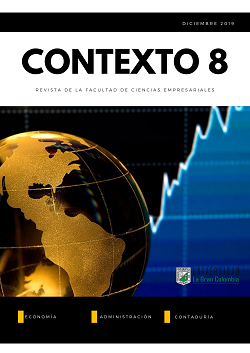Clasificación borrosa de la solvencia financiera corporativa
Palabras clave:
Algoritmo, fuzzy c-means, clasificación borrosa, ratios financieros, solvencia financieraResumen
El objetivo de este documento es proponer y evaluar una metodología a partir del uso de ratios financieros y el algoritmo de clasificación no supervisada fuzzy c-means, en el estudio de la solvencia financiera corporativa. En la primera parte, se establece la necesidad de estudiar la solvencia financiera como aspecto clave de la sostenibilidad financiera de las compañías. Posteriormente, se establecen los elementos claves de la metodología, los ratios financieros empleados y las generalidades de los procesos de clasificación borrosa. Finalmente, se aplica dicha metodología en el sector textil de Colombia a partir de la información financiera extraída de la Superintendencia de Sociedades, determinando sus ventajas y aportes.Descargas
Referencias
Alaka, Hafiz A., Lukumon O. Oyedele, Hakeem A. Owolabi, Vikas Kumar, Saheed O. Ajayi, Olugbenga O. Akinade, and Muhammad Bilal. 2018. “Systematic Review of Bankruptcy Prediction Models: Towards a Framework for Tool Selection.” Expert Systems with Applications 94:164–84.
Barboza, Flavio, Herbert Kimura, and Edward Altman. 2017. “Machine Learning Models and Bankruptcy Prediction.” Expert Systems with Applications 83:405–17.
Altman, E. (1968). Finalcial ratios discriminant analysis and the prediction of corporate bankruptcy. Journal of Finance, 4(23), 589-609.
Altman, E. (2005). An emerging market credit scoring system for corporate bonds. Emerging Markets Review, 6, 311-323.
Altman, E., Hedelman, R., & Narayanan, P. (1977). Zeta Analysis. A new model to identify risk of corporations. Journal of Banking and finance, 29-54.
Beaver, W. (1966). Financial Ratios as Predictors of Failure. Journal of Accounting Research, 71-111.
Bellman, R., Kalaba, R., & Zadeh, L. (1966). Abstraction and pattern classification. J. Math Anal. Appl., 581-586.
Bezdek, J. (1981). Pattern Recognition With Fuzzy Objective Function Algorithms. New York: Plenum Press.
Bezdek, J., Ehrlich, R., & Full, W. (1984). FCM: The fuzzy c-means clustering algorithm. Computers and Geosciences, 10(2-3), 191-203.
Carroll, A. B. (2015). Corporate social responsibility: The centerpiece of competing and complementary frameworks. Organizational Dynamics(44), 87-96.
Castiblanco, F., Montero, J., Rodríguez, J. T., & Gómez, D. (2017a). Quality assessment of fuzzy classification: An application to solvency analysis. Fuzzy economic review, 22(1), 19-31.
Castiblanco, Fabián, Camilo Franco, Javier Montero, and J. Tinguaro Rodríguez. (2018). “Relevance of Classes in a Fuzzy Partition. A Study from a Group of Aggregation Operators.” in Communications in Computer and Information Science.
Castiblanco, Fabián, Camilo Franco, Javier Montero, and J. Tinguaro Rodríguez. (2019). “Aggregation Operators to Evaluate the Relevance of Classes in a Fuzzy Partition.” in Advances in Intelligent Systems and Computing.
Castiblanco, Fabian, Daniel Gómez, Javier Montero, and J. Tinguaro Rodríguez. (2017b). “Aggregation Tools for the Evaluation of Classifications.” in IFSA-SCIS 2017 - Joint 17th World Congress of International Fuzzy Systems Association and 9th International Conference on Soft Computing and Intelligent Systems.
Gerasimova, E. B., & Redin, D. V. (2015). Analyzing and Managing Financial Sustainability of the Company in Turbulent Environment. Mediterranean Journal of Social Sciences, 4(6), 138-143.
Ibarra, A. (2011). Desarrollo del análisis factorial multivariable aplicado al análisis financiero actual. Obtenido de http://www.eumed.net/libros/2010a/666/.
Kaufmann, M., Meier, A., & Stoffel, K. (2015). Membership function generation for inductive fuzzy classification. Expert Systems with applications, 8369-8379.
NU. CEPAL. (2018). Agenda 2030 y los Objetivos de Desarrollo Sostenible: una oportunidad para América Latina y el Caribe. Santiago de Chile: Publicaciones de las Naciones Unidas.
Plasencia Soler, J., Marrero Delagado, F., Bajo Sanjuán , A., & Nicado García, M. (2018). Modelos para evaluar la sostenibilidad de las organizaciones. Estudios gerenciales, 34(146), 63-73.
Yang, M. (1993). A survey of fuzzy clustering. Math. Comput. Modelling, 1-16.
Zadeh, L. (1965). Fuzzy sets. Information and Control 8, 333-353.







